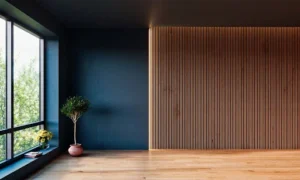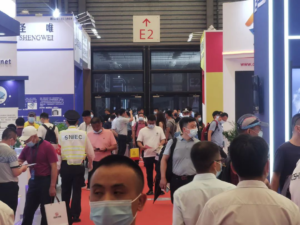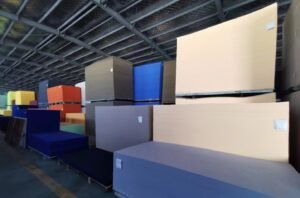What is sound-absorbing material?
Sound-absorbing material (sound-absorbing material): Any material can absorb sound, but the degree of absorption is very different. Generally, materials with an average sound absorption coefficient of more than 0.2 for the above six frequencies are listed as sound-absorbing materials. Sound-absorbing materials Most of the sound-absorbing materials are loose and porous materials, such as slag wool, blankets, etc. The sound-absorbing mechanism is that sound waves penetrate into the pores of the material, and the pores are mostly open holes that communicate with each other internally, subject to friction and viscous resistance of air molecules. And make the fine fibers vibrate mechanically, so that the sound energy can be converted into heat energy. The sound absorption coefficient of this kind of porous sound-absorbing material generally increases gradually from low frequency to high frequency, so the sound absorption effect on high frequency and intermediate frequency is better.
How to choose sound-absorbing material
- Check whether there is a test report for the performance of the sound-absorbing panel: pay attention to whether the sound-absorbing panel sold by the manufacturer and the sample sent for inspection are the same product. If the samples submitted for inspection are thickened, heavier, made of different materials or specially treated, and the samples actually sold are different products, then the products sold will obviously not reach the sound insulation value indicated in the test report. From this aspect, consumers should pay attention to distinguishing the qualifications, credits and goodwill of manufacturers, and avoid being deceived as much as possible.
- Check whether the installation of the sound-absorbing panel is simple: in order to achieve a good sound insulation effect, the installation method of the sound-absorbing panel must be very simple, otherwise it is difficult to achieve the ideal sound insulation effect. Professional acoustic engineers know that if a wall can insulate X decibels in the laboratory, it can only insulate X-2 decibels in actual engineering, and the sound insulation effect is even lower.
What are the sound-absorbing materials?
- Sound-absorbing material velvet. Cheap, fireproof, poor moisture resistance.
- Petroleum fiber cotton. It melts when exposed to fire, does not absorb water, and is not resistant to dirt. It is not easy to absorb high-frequency noise, and the sound absorption effect is poor.
- Sponge. Which are mostly used in recording studios. Easy to absorb dust, not flame retardant.
- Aluminum silicate wool. Fire-resistant, non-absorbent, not stain-resistant. It is not easy to absorb high-frequency noise and is not environmentally friendly.
- Rubber sheet. The shock absorption ability is weaker than that of the asphalt board, and the sound absorption ability is stronger. Self-heavy and difficult to construct.
- Industrial rubber and plastic panels. It is mostly used in thermal insulation equipment or air conditioning industry in which construction industries. Sound insulation, shock absorption ability is strong, cheap. Insufficient: No sound-absorbing material has peculiar smell.
- Modified sponge. The problem of water absorption is solved, and the ability of sound insulation is weakened.
- Glass fiber cotton. Sound insulation and other properties are good, water absorption, heat preservation and heat insulation, this sound-absorbing material does not spontaneously combust, and is anti-corrosion and moisture-proof. It is not environmentally friendly, and those in the industrial field have been phased out.
- Fiber blanket, industrial felt. Only for the floor and roof, cheap. No waterproof, fireproof, anti-corrosion.
- Foamed silica gel plate. Non-flammable, waterproof and environmentally friendly. Good sound insulation and shock absorption, long life. The sound absorption performance is average. The price/performance ratio is not high.
- Asphalt board. Waterproof, shock absorption, sound absorption effect is good. Not flame retardant, polluting, and cheap sound-absorbing materials. Self-important.
- Styrofoam. It does not absorb water and has a higher price with fire resistance. General effect. which
- Aluminum foil composite material. Light weight, good reflection of sound waves. The composite layer generally absorbs water; has poor fire resistance; and reflects a large amount of heat energy.
- Polyurethane foam. It has good sound insulation and sound absorption performance, anti-corrosion and waterproof, and some have flame-retardant design. The sound absorption performance is unstable.
- Sound-absorbing coating. Sound-absorbing materials are generally effective. which
- Sound insulation felt. The sound insulation performance is good, and the material has no sound absorption ability. Some are moisture-proof, moth-proof, and flame-retardant.
How sound-absorbing materials reduce noise
Sound-absorbing materials play a very important role in reducing indoor noise and improving indoor sound quality, and have been paid more and more attention by people. There are many kinds of sound-absorbing materials. Different materials, different appearances, and different structures have different sound absorption coefficients. When using them, the number of sound-absorbing materials can be determined according to calculations. When selecting specific materials, the requirements for sound absorption and aesthetics must be considered. Generally, drywall sound absorption is to lay sound-absorbing materials on the light steel keel and the cavity between the keel to form a sound-absorbing structure system, such as: sound source wooden sound-absorbing board, polyester fiber sound-absorbing board, wood wool sound-absorbing board, etc. Good choice for decoration and acoustic design
Since the conference hall adopts short reverberation, it is necessary to choose a structure with strong sound absorption. And because of the strong sound absorption treatment, architects often adopt various shapes that are likely to cause acoustic defects, such as circles, ellipses, oval planes, and dome roofs. As for the measures to control sound quality defects, in addition to configuring the diffusion structure, a strong sound absorption method is usually used, because it also plays a role in controlling the reverberation time.




